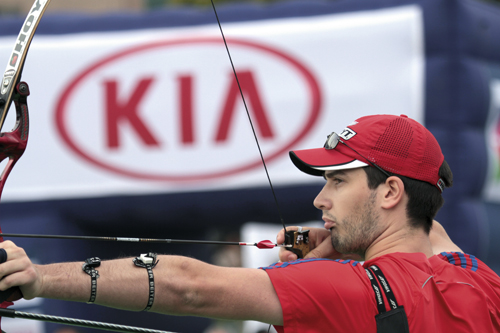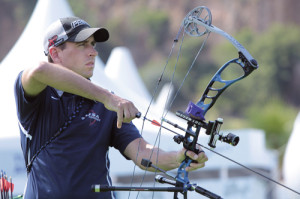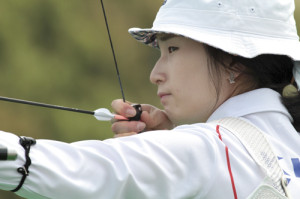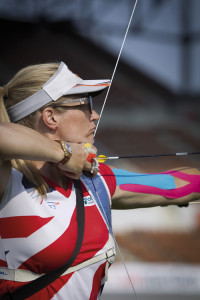Top coach James Park reveals what you need to think about in order to both optimise your performance and minimise chances of injury
In any sporting activity we need to use our body in the best way to optimise our performance, but also to try to minimise the likelihood of injury. I guess we could simply decide that any possibility of injury should not be accepted and simply sit in front of the television, but that, for me at least, has zero appeal – I would rather be out there participating in the sport.

Good front shoulder position will help spread the load of the draw weight through the skeletal structure
The way we use our body is generally described as ‘biomechanics’. While that term might be commonly associated with some mystique, it seems to me to be rather straightforward. What we are trying to do is to use our body in the manner that best enables us to aim the bow without wobbling too much, hold the bow at a consistent full draw position from shot to shot, and to not wear out too quickly from the effort it all takes.
Where that leads is that we want archers to take the forces primarily directly along their bone structure and directly through the joints. That avoids having to use too much muscle power, and hence helps us hold the bow more steadily and to wear out more slowly.

While the load on a recurver’s shoulder joint increases towards the end of the draw, it is high throughout the draw for a compound archer
Next, where we have no alternative to the use of muscle power, we need to have our archers as far as possible use only large muscles, and to only use muscles that need to be used. That is, to never have muscles working unnecessarily or against each other, as that reduces our steadiness and has us wear out much faster than we wish.
Note that once we put a muscle under load in drawing the bow, it is then very difficult to stop using that muscle when we are at full draw. That tells me that we should draw the bow using the muscles that are necessary to hold the bow at full draw – we should not have a ‘transfer phase’ as that immediately results in increased muscle use.
For example, if we have our drawing arm elbow joint on the line of force (the line
between where we are holding the string and the bowhand position on the bow) it is not necessary to use the drawing arm bicep muscle to hold the bow at full draw. Any use of that muscle while at full draw is just wasting energy, reducing our steadiness and opening up a range of technique errors in our release. Consequently, we should draw the bow in a manner that does not require use of the biceps during the draw.
Accompanying the above biomechanical considerations we need to think about the potential for injury, and here I try to make no compromises – I do not like seeing my archers with injuries, particularly injuries that have resulted from poor technique.
I would like to consider just one aspect of our technique in this article – the bow arm shoulder joint, as that is an area often injured by archers. It is a very versatile but complex joint, and typical injuries involve the four rotator cuff muscles and their tendons, or the cartilage between the bones.
The rotator cuff muscles are small muscles deep within the shoulder joint. The best approach to protecting them is simply not to use them. If you let your bow arm hang loosely by your side the rotator cuff muscles should not be in use – that is the orientation of the upper arm bone (the humerus) that we need to retain. Raising the bow arm to horizontal while keeping your palm aimed straight at the ground (that is, with your hand in a horizontal plane when your arm is horizontal) you should then still have the rotator cuff not in use, as desired. In that position, if you then flex your bow arm elbow joint, you should have your forearm at an angle of about 10 degrees to the horizontal – it is an easy check on the angular orientation of the humerus. Your deltoid muscle (a large muscle) will be doing most of the work to hold your bow arm up.
With your arm straight again, you then need to be able to place your bow hand on the bow without rotating your humerus (which would then have you using the rotator cuff, which we are trying to avoid). You can do that very satisfactorily so long as you keep your bow hand knuckles at about an angle of 45 degrees to the horizontal. We certainly don’t want to see the bow hand knuckles vertical as that would give both a poor bow hand position and results in you rotating the humerus.
Second, we need to try to avoid moving the bow arm shoulder joint while it is under heavy load from the bow, as doing so would place large loads on the cartilage. The highest load on that joint for a recurve archer comes towards the end of the draw. For a compounder, it is high for most of the draw.
That is, you need to put your bow arm shoulder joint and bow arm in the position they will be in at full draw, and then draw the bow without major movements to that position. In addition, we want the orientation of the archer’s chest to remain approximately as it will be at full draw while the bow is drawn as otherwise we will be stressing the bow arm shoulder joint cartilage. That can be quite readily accomplished by having your drawing arm forearm at about nose or eye level during most of the draw and keeping the string in close to your bow arm during the draw (rather like the manner in which the very successful Korean women’s recurve team draw their bows, in fact). ⁄




Very good post. I certainly love this website. Thanks!
Awesome post.